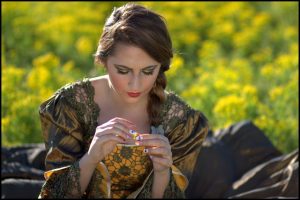 Down the ages there have been two important Types of characters in storytelling: heroes and heroines. The Hero was the character the storyline followed, relating his trials and victories. The Heroine was the character the Hero loved, won, and came home to. Joseph Campbell in The Hero With a Thousand Faces (Princeton University Press: 1973) explicates what he calls the “monomyth” of the Hero, the pattern of the Hero’s quest and the type of events which he encounters. Much, indeed, has been written on Heroes. Much less has been said about Heroines. Ralph Tymns in The Double in Literature (Bowes & Bowes: 1949) makes these observations of two Types of the Heroine:
Down the ages there have been two important Types of characters in storytelling: heroes and heroines. The Hero was the character the storyline followed, relating his trials and victories. The Heroine was the character the Hero loved, won, and came home to. Joseph Campbell in The Hero With a Thousand Faces (Princeton University Press: 1973) explicates what he calls the “monomyth” of the Hero, the pattern of the Hero’s quest and the type of events which he encounters. Much, indeed, has been written on Heroes. Much less has been said about Heroines. Ralph Tymns in The Double in Literature (Bowes & Bowes: 1949) makes these observations of two Types of the Heroine:
The blue-eye, fair-haired, light complexioned one is the Fair Maiden, alias the Persecuted Maiden, the Virgin, the Saint, the Pale Lady, the Good Woman, the Nice Girl, the Marriageable Young Lady. Her darker counterpart is the Femme Fatale, alias the Temptress, the Vamp, the Sinner, the Dark Lady, the Bad Woman, the Naughty Girl, the Trollop. Sometimes she is called Mistress or Prostitute or Even or Whore of Babylon, depending on circumstances. (DL, p. 126)
This is, of course, an extreme and simple analysis of the two Types of Heroine, for both have positive and negative presentations. Additionally the Heroine can appear in the three-form possibilities of Maiden, Matron and Hag. So often, for the Storyteller, the Heroine serves to depict some element or quality the Hero needs to deal with. Indeed, Maud Bodkin observes in Archetypal Patterns in Poetry (Oxford University Press: 1963) that
It is in the process of fantasy that the contemplated characters of things are broken from their historical setting and made available to express the needs and impulses of the experiencing mind. (APP, p. 7)
If the Sub-Creator is using his Heroes and Heroines in order to examine the nature of something, then perhaps the gender of the characters has little to do with their function. Perhaps it is only tradition that sets the pattern.
If gender is not important to the functions of Heroes and Heroines, what qualities are important? Campbell calls his perception of the Hero a “monomyth”, which indicates a singular quality tot he function of the Hero, no matter what personality is given the Hero. Campbell’s study deals with the elements of the Hero’s quest and its progress. By this we can determine that the Hero represents the quality of action. Using Tymns’ observations, we can begin to perceive the quality represented by the Heroine, a quality which we might call the “essence”. The Heroine usually represents for the Hero the essences of love or wisdom or socialization.
The Hero’s quest is the quest of Self, and traditionally the Hero’s union with the Heroine at the end signified reintegration in Society. The Hero’s quest springs up in isolation, alienation and exile, and if in the story it is an isolation, from Society, in the character it is an isolation from the Self. Campbell observes
From the standpoint of the way of duty, anyone in exile from the community is a nothing. From the other point of view, however, this exile is the first step of the quest. Each carries within himself the all; therefore it may be sought and discovered within. The differentiations of sex, age, and occupation are not essential to our character, but mere costumes which we wear for a time on the stage of the world. The image of man within is not to be confounded with the garments. (HTF, p. 385)
The Quest is an inner one, and as Campbell points out, the form of its main character is merely a costume for the Self.
 It might be more helpful, then, to call the two functions of the Quest the Quality of Action and the Quality of Essence, rather than Hero and Heroine, for in recent years, the force of tradition has been weakening. In many recent works, female characters have been assuming the role of “hero”, the quester, the active character. Tradition does still hold sufficient sway to keep the other reversal at a minimum: the part of the passive, “essential” anchor is not yet often given to male characters.
It might be more helpful, then, to call the two functions of the Quest the Quality of Action and the Quality of Essence, rather than Hero and Heroine, for in recent years, the force of tradition has been weakening. In many recent works, female characters have been assuming the role of “hero”, the quester, the active character. Tradition does still hold sufficient sway to keep the other reversal at a minimum: the part of the passive, “essential” anchor is not yet often given to male characters.
What could be provoking this change in the function assigned to female characters? It is not simply the growing social consciousness of the equality of the sexes. By looking at the nature of the quest and not its characters, we may find a key. Could it be that alienation is so pervasive a factor in modern life that resocialization is deemed irrelevant? Could it be that the quest for Self takes all the importance of meaning in a story, and that therefore female characters (who in addition to traditionally representing “essential” qualities also often represent the sub-conscious) are better suited to the modern quest mode? What ever the actual cause, any Sub-Creator would do well to remember the functions of Hero and Heroine, whether the “Hero” is masculine or feminine. Randal Helms, in Tolkien’s World (Houghton Mifflin: 1974) makes these observations of the handling of the Heroes in modern works:
A hero is the expression of a culture’s ideals about itself, and our ideals about ourselves have all been punctured. Cultural ideals are formulated and understood most efficiently in myths, and we have lost the ability to participate wholeheartedly in mythic belief, lost in fact the key to respond to our culture’s central mythic system…. Most contemporary heroic fantasy is vulgar and debasing – struggle against will, rescue of good – but because those themes are unsupported by a resonant image of man: they lack a vital superstructure of ideas. (TW, p. 150)
In order to avoid this hollow vulgarity, then, the Sub-Creator must remember that his Hero and Heroine are not simply characters moving through events, but that they are qualities that have meaning for his readers. Although few Authors begin to form their story by focusing on meaning of what they wish to say, they should not ignore it. The object of the Hero’s quest – on the level of the story’s (meaning), not its events – is internal growth, to achieve the spiritual balance which is often represented in the figure of the Heroine. The Heroine serves to call the Hero onward to the completion of the quest.
Admittedly, when one is discussing Types in literature, the exceptions leap to mind, the characters who do not precisely fit the pattern. There are the Heroines who are active participants in the journey of the quest, not simply the reward waiting at the end of the quest, not simply the reward waiting at the end of the trials; there are the Fair and Dark Heroines who break their Type; the Heroes who skip elements in the quest or who do not achieve self-awareness and resocialization. But these are “made available to express the needs and impulses of the experiencing mind” (APP, p. 7).
Campbell has this to say of the meaning of the quest, unfractured by being separated into Hero and Heroine:
The aim is not to see, but to realize that one is, that essence; then one is free to wander as that essence in the world. Furthermore; the world too is of that essence. The essence of oneself and the essence of the world; these two are one. Hence separateness, withdrawal, is no longer necessary. Wherever the hero may wander, whatever he may do, he is ever in the presence of his own essence – for he has the perfected eye to see. There is no separateness. Thus, just as the way of the social participation may lead in the end to a realization of the All in the individual, so that of exile brings the hero to the Self in all. (HTF, p. 386)
How the Author handles his characters, the depth of recognition he shows as to (what) his characters represent in the tale, can affect how honestly and freely he deals with them in the telling of the story. The Author’s understanding can give the Hero and Heroine (for those who are filling their functions) the free rein they need in order to achieve the quest. But a failure – whether conscious or sub-conscious – to understand the Qualities of Hero and Heroine will only cripple the characters. The stronger grasp an Author’s awareness has of this truth, the surer touch it will have in breathing life into the questers, the Heroes and Heroines.
(first published in Mythlore 43, Autumn 1985; revised 2007)

Pingback: Searching For Heroines - Scribbler's Guide to MythScribbler's Guide to Myth